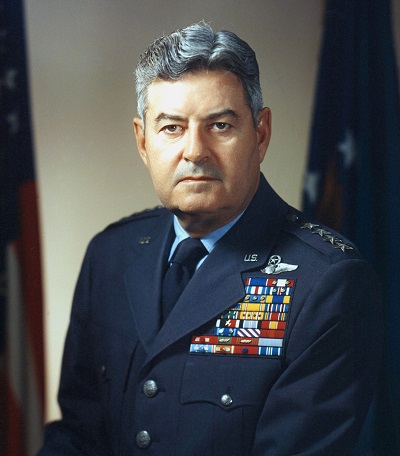
|
General Curtis Emerson LeMay |
 |
||||||||
|---|---|---|---|---|---|---|---|---|---|---|
 |
 |
 |
 |
 |
 |
 |
 |
 |
 |
|
Curtis LeMay joined the U.S. Army Air Corps while studying civil engineering at Ohio State University and was commissioned a second lieutenant in the Air Corps Reserve in October 1929. He became a pursuit pilot with his first duty station at Selfridge Field with the 27th Pursuit Squadron and transferred to bomber aircraft in 1937 where he specialized in aerial navigation training. He was the lead navigator in a group of three planes from the 2nd Bombardment Group that intercepted the Italian passenger liner Rex, 700 miles (1,125 km) offshore the eastern seaboard of the United States, in May 1938. The mission was to prove the capabilities of the Boeing B-17 Flying Fortress. In 1940 he was navigator on the prototype Boeing XB-15 heavy bomber, flying a survey from Panama over the Galapagos islands. By the time of Japan's Attack on Pearl Harbor on December 7, 1941 he rose to the rank of major. | |

|
He commanded the 305th Operations Group from October 1942 until September 1943, and the 3rd Air Division in the European theatre of World War II until August 1944 as part of the Eighth Air Force. He was then transferred to the China Burma India Theater and then placed in command of strategic bombing operations against Japan. His strategy was to execute massive fire-bombing against Japanese cities with Boeing B-29s and minelaying operations in Japan's internal waterways. After the war, he was assigned to command USAF Europe and coordinated the Berlin Airlift. He served as commander of the Strategic Air Command (SAC) from 1948 to 1957, where he presided over the transition to an all-jet aircraft force that had a strong emphasis on the delivery of nuclear weapons. LeMay was appointed Vice Chief of Staff of the United States Air Force in July 1957, serving until 1961. From 1961 to 1965, LeMay was made the fifth Chief of Staff of the United States Air Force. |
© The Aviation History On-Line Museum.
All rights reserved.
January 27, 2023.